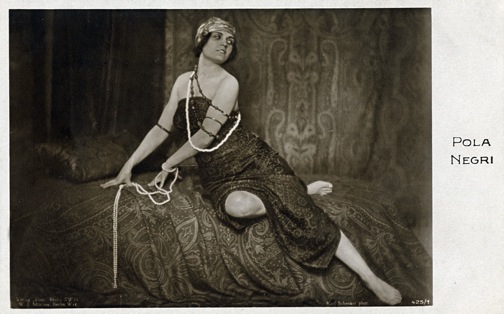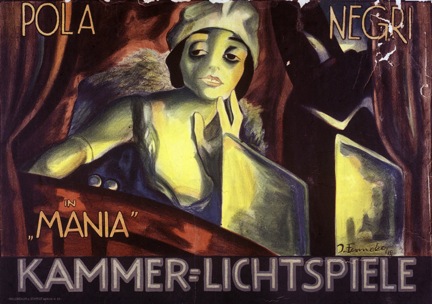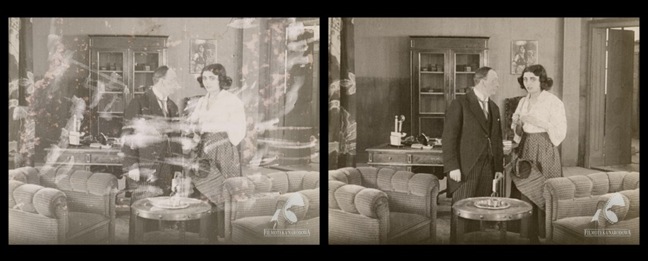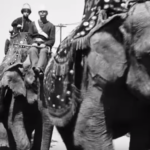Polish Star Rises Again
Pola Negri’s Early Vehicle, Mania, Discovered and Fully Restored
She Dazzled Audiences in Her Day – Even Chaplin and Valentino

Early-film fans in Paris, Madrid, London, Kiev, and Berlin are being treated this month and next to presentations with live chamber-orchestra accompaniment of a restoration of a Negri vehicle long thought lost, the 1918 Polish silent Mania: The History of a Cigarette Factory Worker.
In 2006, the Polish National Film Archive, Filmoteka Nardowa, acquired a decaying print of Mania from a Czech collector, and now has restored it to sparkling condition.
Eugen Illés directed the 85-minute film for the German production company Projektions-AG. Born Jenö Illés in 1877 in Hungary, he made some 30 films in Germany and elsewhere in Europe before his death in Budapest in 1951.
The film depicts a cigarette factory worker, Mania, and her great love for a talented composer, Hans van den Hof, played by Arthur Schroder. Her dancing and beauty captivate the art patron Morelli (Werner Hollman). He desires Mania as his mistress, so he offers to put van den Hof’s new opera on stage, if only. Selflessly, Mania agrees.
Things end badly.
Negri starred in it as a 20-year-old diva in the making. Like many another silent-era ingénues-turned-vamp, she appealed to audiences due to her exotic beauty and rather over-the-top expressiveness.
Born Barbara Apolonia Chałupiec in 1897 near Warsaw (full biography), Negri was the daughter of a Slovak gypsy. She began her artistic life as a dancer, but tuberculosis led her to aspire to an acting career, instead. When she began to appear on stage, she took a new name from the poet Ada Negri, and proved a sensation.
That led to her first movie role, in 1914. She played the lead in Jan Pawlikowski’s Slave to her Senses, which began to establish her characterization as a vamp and femme fatale. That led to starring role in Beasts, the Mysteries of Warsaw series, and other productions of the Sfinks company run by Aleksander Hertz.
Mania: Die Geschichte Einer Ziragettenarbeiterin dates from a second phase of her film career, one of greater popularity.

The same year, she married Count Eugeniusz Dębski, the head of the Polish customs in Sosnowie, but soon left him to lead a high-style life in leather boots, turbans, and exotic jewellery. She moved to the United States in 1923 to star in Paramount Pictures productions at the dawning of talkies, and made several films before again working with Lubitsch, in Forbidden Paradise, a 1924 box-office hit about Katharine the Great longing for a new lover.
Negri was finding a few of those herself, most famously Charlie Chaplin, whom she had met in Berlin and eventually almost married, and then Rudolf Valentino, the love of her life who died unexpectedly from post-operative complications in 1926.
Negri continued acting in movies, and married an immigrant from Georgia, Count Sergiusz Mdivany, again only briefly.
She played in her last silent film, The Way of Lost Souls, in 1929 in England, and also returned to the stage singing gypsy songs and ballads. Acclaim for her voice led her to return to Hollywood, where her first spoken part was as Maria Draga, a beautiful cabaret singer married to King Aleksander of Serbia in Paul Ludwig Stein’s A Woman Commands. Her song “Paradise” from the film became a hit.
When no other Hollywood offers came, Negri returned to the stage again, and to movie roles in Germany. There, her success became her downfall. Playing a singer in Willie Frost’s UFA production, Mazurka, she sang two songs in German that appealed to Adolf Hitler and earned her the nickname “Fuehrer’s favourite artist.” She didn’t like that, and nor did Joseph Goebbels, Hitler’s propaganda brains. He banned her films after alleging that she had taken part in anti-German activities abroad and was Jewish on her father’s side.
Negri succeeded in having the ban lifted, but Hollywood stopped calling, and she worked on in Germany, still playing such characteristic roles as cabaret singers, Madame Bovary, and the militant mother of an illegitimate child.

She died in San Antonio in 1987, aged 90.
Filmoteka Narodowa, the Polish National Film Archive, has fully restored Mania, which was renowned in its day for its camera innovations and elaborate scenery, as part of the project Preservation and Digitalisation of Pre-War Movies in Warsaw‘s Filmoteka Narodowa.
It is being shown in the European capitals as part of an arts and culture initiative mounted by the Polish government to mark the 2011 Polish Presidency in the Council of the European Union. The initiative aims to showcase Polish arts and culture during the second half of this year in 10 capital cities around the world. The Adam Mickiewicz Institute is in charge of the programs, which will include some 400 events designed to present Polish social and economic thought, history, literature, film, music, theatre, and visual arts to an international audience.
Restoration was the only way to make the film suitable for showing, as it was in a state of advanced deterioration, according to Filmoteka Narodowa officials. Among its ailments was that it largely lacked perforation and had shrunk in places. Paweł Śmietanka, head of digital restoration at the national archive, says restoration began with restoring the tape – disconnecting all the connections where the film had broken or been joined for other reasons, and restoring all the film sprockets. Restorationists removed all dirt from the film, and then scanned it, in sections, with a specialty scanner.

In an announcement on the Polish film archive’s site, Śmietanka says: “Taking into account that the film was thought lost for years and that the copy belonging to Filmoteka Narodowa is probably the only one still existing, we believe that by using the newest digital technology we have restored a work from almost a hundred years ago. This is symbolic of the contribution that Filmoteka Narodowa has in one of the most important tasks of the United Europe, which is the preservation of its cultural heritage.”
– Peter Monaghan
Previous Post: A Century of Sooner Cinema
Next Post: Portraits of San Francisco Movie Theatres





